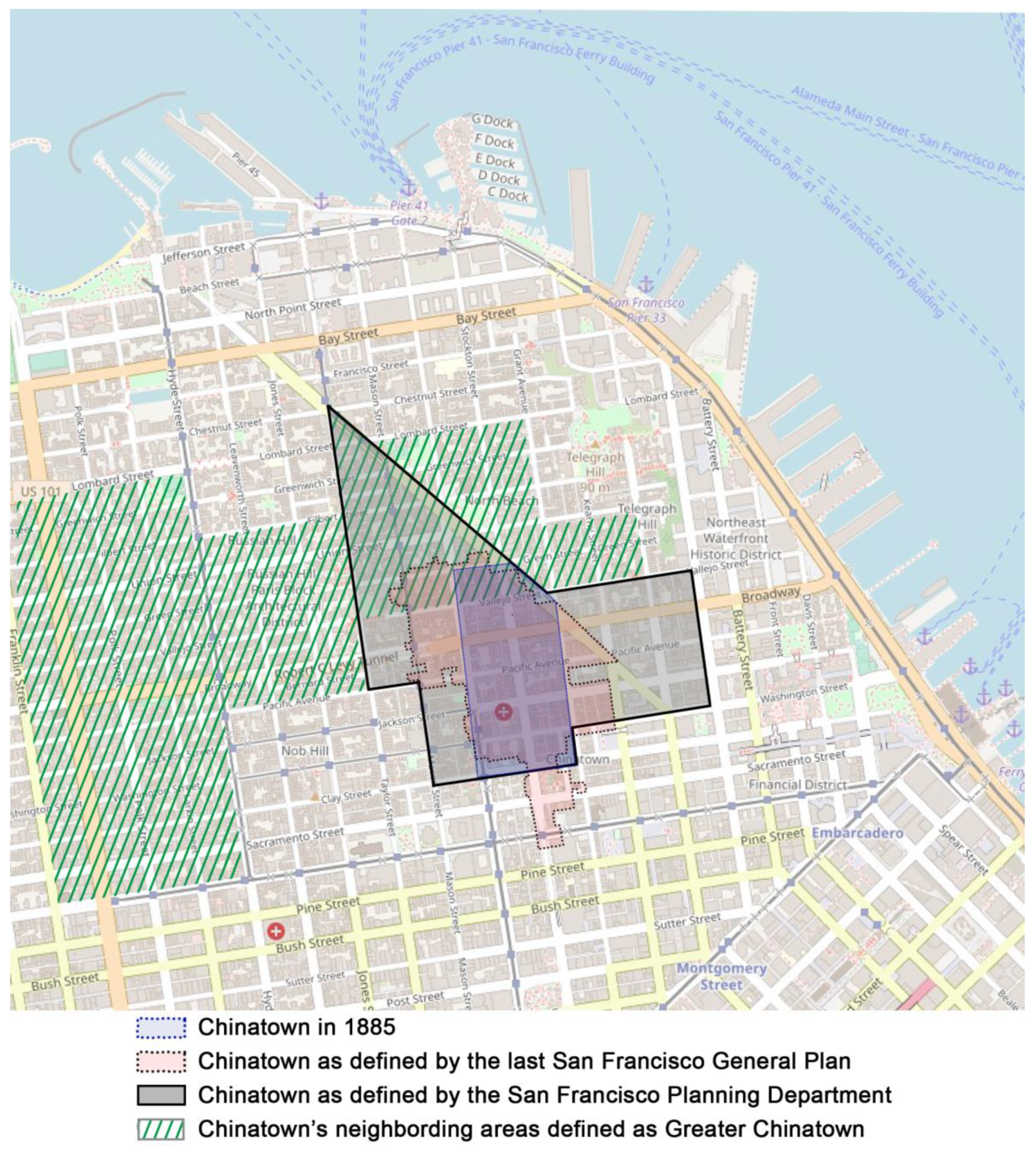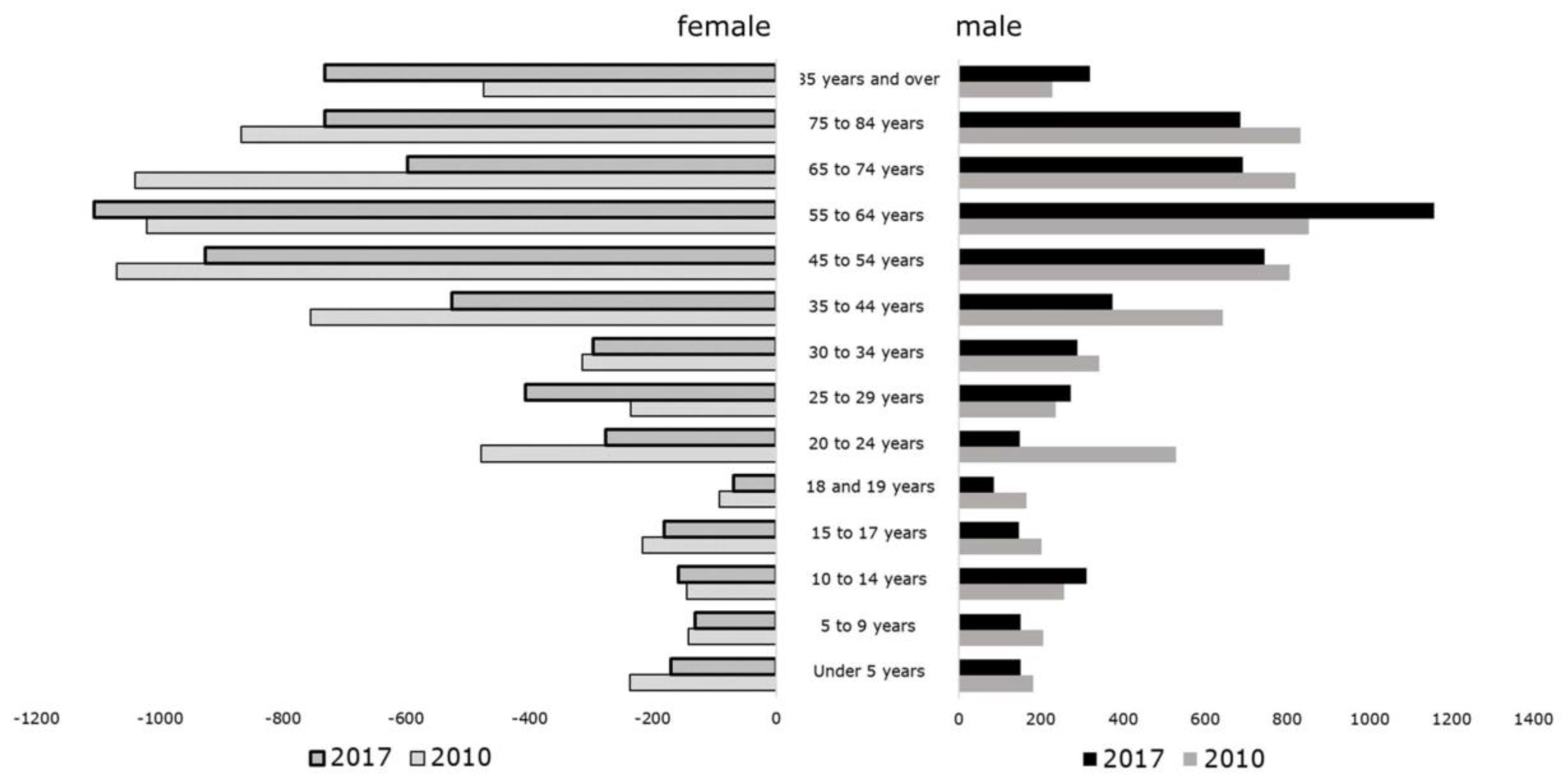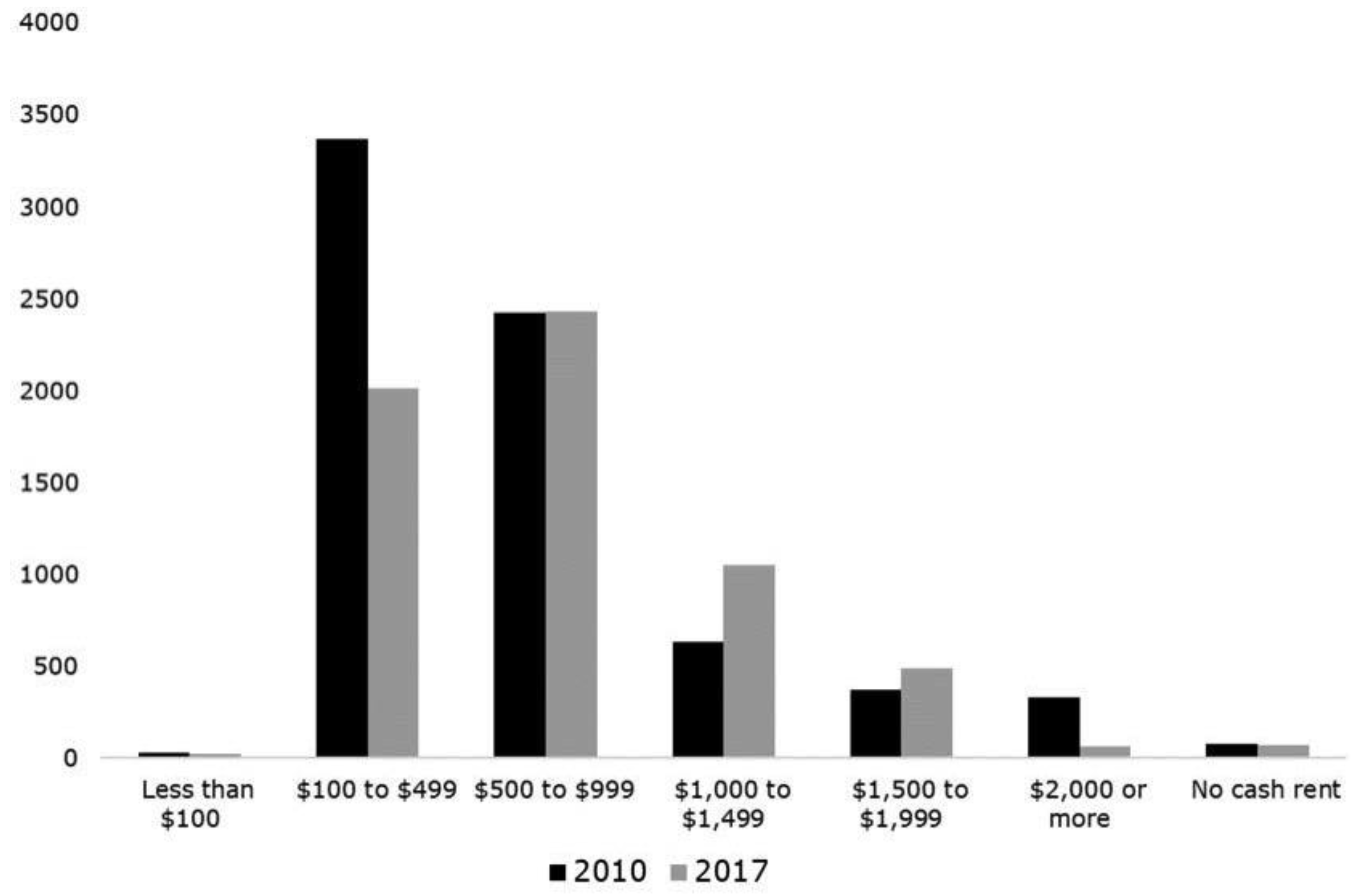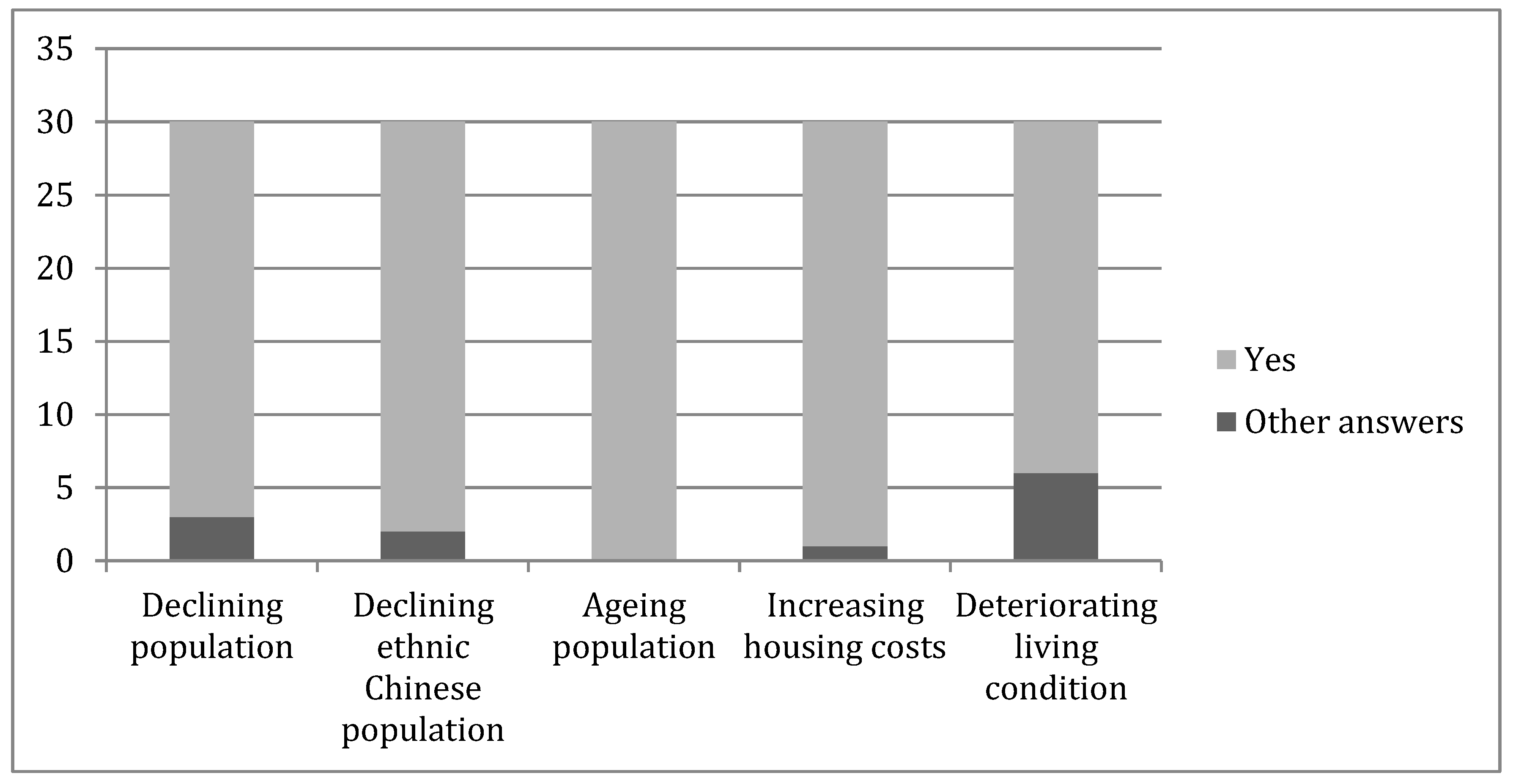Shrinking Historic Neighborhoods and Authenticity Dilution: An Unspoken Challenge of Historic Chinatowns in the United States through the Case of San Francisco
Abstract
1. Introduction
2. Theoretical Background
2.1. Shrinking Cities and Neighborhoods
2.2. Authenticity and Social Sustainability
2.3. Shrinking Neighborhoods, Authenticity, and Social Sustainability
3. Materials and Methods
3.1. Study Area
3.2. Research Method
- What do you think about the changes of Chinatown, in population, housing costs, living condition, and other aspects? What these changes meant to you?
- In your opinion, what elements are authentic or inauthentic in Chinatown? What elements determine Chinatown’s authenticity or inauthenticity? How have you seen the transformation of authenticity in Chinatown?
- What do you think about the future of Chinatown?
4. Results and Discussion
4.1. Chinatown Transformations: Population and Housing Dimensions
4.2. The Perception of Neighborhood Decline and the Experience of Authenticity Dilution: Linking the Debates
4.2.1. A Place Called Home with a Deteriorating Image
4.2.2. Population Ageing and Outmigration
4.2.3. Gentrification and Disneyfication
4.3. Discussion: Policy Implications and Recommendations
5. Conclusions
Author Contributions
Funding
Acknowledgments
Conflicts of Interest
References
- Bontje, M.; Musterd, S. Understanding shrinkage in European regions. Built Environ. 2012, 38, 153–161. [Google Scholar] [CrossRef]
- Martinez-Fernandez, C.; Audirac, I.; Fol, S.; Cunningham-Sabot, E. Shrinking Cities: Urban Challenges of Globalization. Int. J. Urban Reg. Res. 2012, 36, 213–225. [Google Scholar] [CrossRef]
- Großmann, K.; Bontje, M.; Haase, A.; Mykhnenko, V. Shrinking cities: Notes for the further research agenda. Cities 2013, 35, 221–225. [Google Scholar] [CrossRef]
- Pallagst, K.; Wiechman, T.; Martinez-Fernandez, C. Shrinking Cities. International Perspectives and Policy Implications; Routledge: New York, NY, USA, 2014. [Google Scholar]
- Herrmann, D.L.; Shuster, W.D.; Mayer, A.L.; Garmestani, A.S. Sustainability for Shrinking Cities. Sustainability 2016, 8, 911. [Google Scholar] [CrossRef]
- Ročak, M.; Hospers, G.-J.; Reverda, N. Searching for Social Sustainability: The Case of the Shrinking City of Heerlen, The Netherlands. Sustainability 2016, 8, 382. [Google Scholar] [CrossRef]
- Runge, A.; Kantor-Pietraga, I.; Runge, J.; Krzysztofik, R.; Dragan, W. Can depopulation create urban sustainability in postindustrial regions? A case from Poland. Sustainability 2018, 10, 4633. [Google Scholar] [CrossRef]
- Slach, O.; Bosák, V.; Krtička, L.; Nováček, A.; Rumpel, P. Urban Shrinkage and Sustainability: Assessing the Nexus between Population Density, Urban Structures and Urban Sustainability. Sustainability 2019, 11, 4142. [Google Scholar] [CrossRef]
- Dempsey, N.; Bramley, G.; Power, S.; Brown, C. The social dimension of sustainable development: Defining urban social sustainability. Sustain. Dev. 2011, 19, 289–300. [Google Scholar] [CrossRef]
- Maes, M.; Loopmans, M.; Kesteloot, C. Urban Shrinkage and Everyday Life in Post-Socialist Cities: Living with Diversity in Hrušov, Ostrava, Czech Republic. Built Environ. 2012, 37, 229–243. [Google Scholar] [CrossRef]
- Oswalt, P.; Rieniets, T. Atlas of Shrinking Cities; Hatje Cantz Verlag: Ostfildern, Germany, 2006. [Google Scholar]
- Reckien, D.; Martinez-Fernandez, C. Why do cities shrink? Eur. Plan. Stud. 2011, 19, 1375–1397. [Google Scholar] [CrossRef]
- Kroll, F.; Haase, D. Does demographic change affect land use patterns? A case study from Germany. Land Use Policy 2010, 27, 726–737. [Google Scholar] [CrossRef]
- Deng, C.; Ma, J. Viewing urban decay from the sky: A multi-scale analysis of residential vacancy in a shrinking U.S. City. Landsc. Urban Plan. 2015, 141, 88–99. [Google Scholar] [CrossRef]
- Fol, S. Urban shrinkage and socio-spatial disparities: Are the remedies worse than the disease? Built Environ. 2012, 38, 259–275. [Google Scholar] [CrossRef]
- Grossmann, K.; Haase, A.; Arndt, T.; Cortese, C.; Rumpel, P.; Rink, D.; Slach, O.; Tichá, I.; Violante, A. How urban shrinkage impacts on patterns of socio-spatial segregation: The cases of Leipzig, Ostrava, and Genoa. In Urban Ills: Post Recession Complexities to Urban Living in Global Contexts; Yeakey, C.C., Thompsom, V.L.S., Wells, A., Eds.; Lexington Books: Plymouth, UK, 2013; pp. 241–268. [Google Scholar]
- Van Kempen, R.; Bolt, G.; Van Ham, M. Neighborhood decline and the economic crisis: An introduction. Urban Geogr. 2016, 37, 655–663. [Google Scholar] [CrossRef][Green Version]
- Haase, D. Urban ecology of shrinking cities: An unrecognized opportunity? Nat. Cult. 2008, 3, 1–8. [Google Scholar] [CrossRef]
- Bernt, M. Partnerships for Demolition: The Governance of Urban Renewal in East Germany’s Shrinking Cities. Int. J. Urban Reg. Res. 2009, 33, 754–769. [Google Scholar] [CrossRef]
- Bernt, M.; Hasse, A.; Großmann, K.; Cocks, M.; Couch, C.; Cortese, C.; Krzysztofik, R. How dose (n’t) Urban Shrinkage get onto the Agenda? Experiences from Leipzig, Liverpool, Genoa and Bytom. Int. J. Urban Reg. Res. 2014, 38, 1749–1766. [Google Scholar] [CrossRef]
- Hospers, G.-J. Policy responses to urban shrinkage: From growth thinking to civic engagement. Eur. Plan. Stud. 2014, 22, 1507–1523. [Google Scholar] [CrossRef]
- Miot, Y. Residential attractiveness as a public policy goal for declining industrial cities: Housing renewal strategies in Mulhouse, Roubaix and Saint-Etienne (France). Eur. Plan. Stud. 2015, 23, 104–125. [Google Scholar] [CrossRef]
- Mallach, A. What we talk about when we talk about shrinking cities: The ambiguity of discourse and policy response in the United States. Cities 2017, 69, 109–115. [Google Scholar] [CrossRef]
- Galjaard, R.; Van Wissen, L.; Van Dam, K. European Regional Population Decline and Policy Responses: Three Case Studies. Built Environ. 2012, 38, 293–302. [Google Scholar] [CrossRef]
- Hoekveld, J.J. Time-Space Relations and the Differences between Shrinking Regions. Built Environ. 2012, 38, 179–195. [Google Scholar] [CrossRef]
- Wiechmann, T.; Pallagst, K.M. Urban shrinkage in Germany and the USA: A comparison of transformation patterns and local strategies. Int. J. Urban Reg. Res. 2012, 36, 261–280. [Google Scholar] [CrossRef] [PubMed]
- Haase, A.; Rink, D.; Grossmann, K.; Bernt, M.; Mykhnenko, V. Conceptualizing Urban Shrinkage. Environ. Plan. A 2014, 46, 1519–1534. [Google Scholar] [CrossRef]
- Richardson, H.W.; Nam, C.W. Shrinking Cities: A Global Perspective; Routledge/Taylor & Francis Group: London, UK, 2014. [Google Scholar]
- Hasse, A.; Bernt, M.; Großmann, K.; Mykhnenko, V.; Rink, D. Varieties of shrinkage in European cities. Eur. Urban Reg. Stud. 2016, 23, 86–102. [Google Scholar] [CrossRef]
- Hollander, J.B. Can a City Successfully Shrink? Evidence from Survey Data on Neighborhood Quality. Urban Aff. Rev. 2010, 47, 129–141. [Google Scholar] [CrossRef]
- Somerville, P.; Van Beckhoven, E.; Van Kempen, R. The Decline and Rise of Neighbourhoods: The Importance of Neighbourhood Governance. Eur. J. Hous. Policy 2009, 9, 25–44. [Google Scholar] [CrossRef]
- Feldhoff, T. Shrinking communities in Japan: Community ownership of assets as a development potential for rural Japan? Urban Des. Int. 2013, 18, 99–109. [Google Scholar] [CrossRef]
- Yahagi, H. The Nagasaki Model of Community Governance: Grassroots Partnership with Local Government. In Shrinking Cities. International Perspectives and Policy Implications; Pallagst, K., Wiechmann, T., Martinez-Fernandez, C., Eds.; Routledge: New York, NY, USA, 2014; pp. 295–324. [Google Scholar]
- Tintěra, J.; Kotval, Z.; Ruus, A.; Tohvri, E. Inadequacies of heritage protection regulations in an era of shrinking communities: A case study of Valga, Estonia. Eur. Plan. Stud. 2018, 26, 2448–2469. [Google Scholar] [CrossRef]
- Vitiello, D.; Blickenderfer, Z. The planned destruction of Chinatowns in the United States and Canada since c. 1900. Plan. Perspect. 2018, 1–26. [Google Scholar] [CrossRef]
- Asian American Legal Defense and Education Fund (AALDEF). Chinatown Then and Now: Gentrification in Boston, New York, and Philadelphia; ALDEF: New York, NY, USA, 2013. [Google Scholar]
- Acolin, A.; Vitiello, D. Who owns Chinatown: Neighborhood preservation and change in Boston and Philadelphia. Urban Stud. 2018, 55, 1690–1710. [Google Scholar] [CrossRef]
- Montojo, N. Chinatown: Community Organizing Amidst Change in San Francisco’s Chinatown; Center for Community Innovation: Berkeley, CA, USA, 2015; Available online: http://www.urbandis placement.org/sites/default/files/Chinatown_final.pdf (accessed on 31 August 2019).
- Vocativ. The Fight for Chinatown. Available online: https://www.vocativ.com/290583/the-fight-for-chinatown/ (accessed on 31 August 2019).
- Lee, R.H. The Chinese in the United States of America; Hong Kong University Press: Hong Kong, China, 1960. [Google Scholar]
- Zhou, M. Chinatown: The Socio-Economic Potential of an Urban Enclave; Temple University Press: Philadelphia, PA, USA, 1992. [Google Scholar]
- Lin, J. Reconstructing Chinatown: Ethnic Enclave, Global Change; University of Minnesota Press: Minneapolis, MN, USA, 1998. [Google Scholar]
- Li, C. Chinatown and Urban Redevelopment: A Spatial Narrative of Race, Identity and Urban Politics 1950-2000. Ph.D. Thesis, University of Illinois at Urbana-Champaign, Urbana-Champaign, IL, USA, 2011. [Google Scholar]
- Silva, J.A. Assimilation or Isolation? Community-Based Organizations and their Strategies for Redevelopment in Manhattan’s Chinatown. Middle States Geogr. 2001, 34, 73–81. [Google Scholar]
- Chin, G. Building Community, Chinatown Style. A Half Century of Leadership in San Francisco Chinatown; Jay Schaefer Books: San Francisco, CA, USA, 2015. [Google Scholar]
- Li, W. Anatomy of a New Ethnic Settlement: The Chinese Ethnoburb in Los Angeles. Urban Stud. 1998, 35, 479–501. [Google Scholar] [CrossRef]
- Laguerre, M.S. The globalization of a panethnopolis: Richmond district as the New Chinatown in San Francisco. GeoJournal 2005, 64, 41–49. [Google Scholar] [CrossRef]
- Luk, C.M.; Phan, M.B. Ethnic enclave reconfiguration: A ‘new’ Chinatown in the making. GeoJournal 2005, 64, 17–30. [Google Scholar] [CrossRef]
- Xie, S. The dilemma of authenticity in Chinatown’s evolution in the United States through the case of San Francisco Bay Area (in Chinese). New Archit. 2017, 173, 53–58. [Google Scholar] [CrossRef]
- Xie, S. Challenges of authenticity: Exploring the social transformation of historic Chinatowns in the United States for sustainable urban redevelopment through the case of San Francisco. In Proceedings of the ICOMOS 19th General Assembly & Scientific Symposium, New Delhi, India, 11–15 December 2017; Available online: https://www.icomos.org/images/DOCUMENTS/General_Assemblies/19th_Delhi_2017/19th_GA_Outcomes/Scientific_Symposium_Final_Papers/ST1/43._ICOA_555_Xie_SM.pdf (accessed on 1 November 2019).
- Harvey, D. Spaces of Global Capitalism: A Theory of Uneven Geographical Development; Verso: London, UK, 2006. [Google Scholar]
- Ganser, R.; Piro, R. (Eds.) Parallel Patterns of Shrinking Cities and Urban Growth: Spatial Planning for Sustainable Development of City Regions and Rural Areas; Ashgate: Surrey, UK, 2012. [Google Scholar]
- Döringer, S.; Uchiyama, Y.; Penker, M.; Kohsaka, R. A meta-analysis of shrinking cities in Europe and Japan. Towards an integrative research agenda. Eur. Plan. Stud. 2019, 1–20. [Google Scholar] [CrossRef]
- Hollander, J.; Pallagst, K.; Schwarz, T.; Popper, F. Shrinking cities as an emerging planning paradigm. Prog. Plan. 2009, 72, 223–232. [Google Scholar]
- Zwiers, M.; Bolt, G.; Van Ham, M.; Van Kempen, R. The global financial crisis and neighborhood decline. Urban Geogr. 2016, 37, 664–684. [Google Scholar] [CrossRef]
- Trilling, L. Sincerity and Authenticity; Oxford University Press: London, UK, 1972. [Google Scholar]
- MacCannell, D. Staged Authenticity: Arrangements of Social Space in Tourist Settings. Am. J. Sociol. 1973, 79, 589–603. [Google Scholar] [CrossRef]
- Reisinger, Y.; Steiner, C.J. Reconceptualising Object Authenticity. Ann. Tour. Res. 2006, 33, 65–86. [Google Scholar] [CrossRef]
- Zhu, Y. Cultural effects of authenticity: Contested heritage practices in China. Int. J. Herit. Stud. 2015, 21, 594–608. [Google Scholar] [CrossRef]
- Wang, N. Rethinking Authenticity in Tourism Experience. Ann. Tour. Res. 1999, 26, 349–370. [Google Scholar] [CrossRef]
- Florida, R. The Rise of the Creative Class; Basic Books: New York, NY, USA, 2004. [Google Scholar]
- Zukin, S. Naked City: The Death and Life of Authentic Urban Places; Oxford University Press: Oxford, UK, 2010. [Google Scholar]
- Ouf, A.M.S. Authenticity and the sense of place in urban design. J. Urban Des. 2001, 6, 73–86. [Google Scholar] [CrossRef]
- Jive’n, G.; Larkham, P.J. Sense of place, authenticity and character: A commentary. J. Urban Des. 2003, 8, 67–81. [Google Scholar] [CrossRef]
- Pottie-Sherman, Y.; Hiebert, B. Authenticity with a Bang: Exploring Suburban Culture and Migration Through the New Phenomenon of the Richmond Nigh Market. Urban Stud. 2015, 52, 538–554. [Google Scholar] [CrossRef]
- Wesener, A. ‘This Place Feels Authentic’: Exploring Experiences of Authenticity of Place in Relation to the Urban Built Environment in the Jewellery Quarter, Birmingham. J. Urban Des. 2016, 21, 67–83. [Google Scholar] [CrossRef]
- Wesener, A. Adopting ‘Things of the Little’: Intangible Cultural Heritage and Experiential Authenticity of Place in the Jewellery Quarter, Birmingham. Int. J. Herit. Stud. 2017, 23, 141–155. [Google Scholar] [CrossRef]
- Anderson, K. ‘Chinatown re-oriented’: A critical analysis of recent redevelopment schemes in a Melbourne and Sydney Enclave. Aust. Geogr. Stud. 1990, 28, 137–154. [Google Scholar] [CrossRef]
- Bramley, G.; Power, S. Urban form and social sustainability: The role of density and housing type. Environ. Plan. B Plan. Des. 2009, 36, 30–48. [Google Scholar] [CrossRef]
- Yip, C.L. San Francisco’s Chinatown: An Architectural and Urban History. Ph.D. Thesis, University of California, Berkeley, CA, USA, 1985. [Google Scholar]
- United States Census Bureau/American Fact Finder. 2010–2017 American Community Survey. Available online: https://factfinder.census.gov/ (accessed on 30 July 2019).
- San Francisco Planning Department. Report of American Community Survey 2012–2016. San-Francisco Neighborhoods Socioeconomic Profiles; San Francisco Planning Department: San Francisco, CA, USA, 2018. [Google Scholar]
- Library of Congress. Available online: https://www.loc.gov/resource/g4364s.ct002129/?r=-0.006,0.518,0.214,0.13,0l (accessed on 12 December 2019).
- San Francisco Planning Department. Chinatown Area Plan. Available online: https://generalplan.sfplanning.org/Chinatown.htm#CHI_PVN_1 (accessed on 6 July 2019).
- Open Street Map. Available online: https://www.openstreetmap.org/ (accessed on 29 December 2019).
- Alawadi, K. Place attachment as a motivation for community preservation: The demise of an old, bustling, Dubai community. Urban Stud. 2017, 54, 2973–2997. [Google Scholar] [CrossRef]
- Barton, H. Conflicting perceptions of neighborhood. In Sustainable Communities: The Potential for Eco-Neighborhoods; Barton, H., Ed.; Earthscan: London, UK, 2000; pp. 3–18. [Google Scholar]
- Wiechmann, T.; Bontje, M. Responding to tough times: Policy and planning strategies in shrinking cities. Eur. Plan. Stud. 2015, 23, 1–11. [Google Scholar] [CrossRef]
- Molotch, H.; Freudenburg, W.; Paulsen, K.E. History repeats itself, but how? City character, urban tradition, and the accomplishment of place. Am. Sociol. Rev. 2000, 65, 791–823. [Google Scholar] [CrossRef]
- PROTECT the ELLIS ACT. Available online: http://www.preservetheellisact.org/history/ (accessed on 26 November 2019).
- Jacobs, J. The Death and Life of Great American Cities; Random House: New York, NY, USA, 1961. [Google Scholar]
- Zeitschrift fur Architektur und Stadtebau ARCHPLUS. Shrinking Cities–Reinventing Urbanism. Available online: http://www.shrinkingcities.com/index.php%3Fid=227&L=1.html (accessed on 9 December 2019).





| Ages | 1–14 | 15–24 | 25–34 | 35–44 | 45–54 | 55–64 | 65–74 | 75–84 | ≥85 | Total |
|---|---|---|---|---|---|---|---|---|---|---|
| Number of interviewees | 1 | 4 | 6 | 4 | 3 | 5 | 4 | 2 | 1 | 30 |
| Races | Ethnic Chinese | Non-Asian | Asian but not ethnic Chinese | Total | ||||||
| Number of interviewees | 24 | 4 | 2 | 30 | ||||||
| Categories | Authentic Experiences | Inauthentic Experiences |
|---|---|---|
| Built environment |
|
|
| Population structure | High proportion of the ethnic Chinese population |
|
| Community function | A traditional Chinese-style living community with:
| Functional displacement toward a touristic thematic park or ethnic Disneyland with:
|
| Community living condition |
|
|
© 2019 by the authors. Licensee MDPI, Basel, Switzerland. This article is an open access article distributed under the terms and conditions of the Creative Commons Attribution (CC BY) license (http://creativecommons.org/licenses/by/4.0/).
Share and Cite
Xie, S.; Batunova, E. Shrinking Historic Neighborhoods and Authenticity Dilution: An Unspoken Challenge of Historic Chinatowns in the United States through the Case of San Francisco. Sustainability 2020, 12, 282. https://doi.org/10.3390/su12010282
Xie S, Batunova E. Shrinking Historic Neighborhoods and Authenticity Dilution: An Unspoken Challenge of Historic Chinatowns in the United States through the Case of San Francisco. Sustainability. 2020; 12(1):282. https://doi.org/10.3390/su12010282
Chicago/Turabian StyleXie, Shuyi, and Elena Batunova. 2020. "Shrinking Historic Neighborhoods and Authenticity Dilution: An Unspoken Challenge of Historic Chinatowns in the United States through the Case of San Francisco" Sustainability 12, no. 1: 282. https://doi.org/10.3390/su12010282
APA StyleXie, S., & Batunova, E. (2020). Shrinking Historic Neighborhoods and Authenticity Dilution: An Unspoken Challenge of Historic Chinatowns in the United States through the Case of San Francisco. Sustainability, 12(1), 282. https://doi.org/10.3390/su12010282






